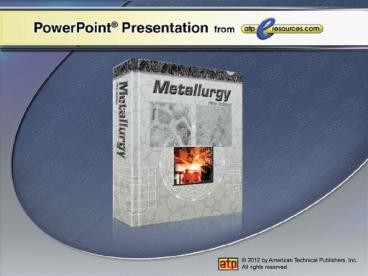Positive Materials Identification - PowerPoint PPT Presentation
1 / 23
Title:
Positive Materials Identification
Description:
Metal color identification is a technique used to group metals according to their characteristic colors. See Figure 9-6. However, heat tints from heat treating ... – PowerPoint PPT presentation
Number of Views:783
Avg rating:3.0/5.0
Title: Positive Materials Identification
1
(No Transcript)
2
Chapter 9
- Positive Materials Identification
Existing Material Identifications
Identification Methods Portable Quantitative
Analysis Laboratory Quantitative Analysis
3
- Foundry marks are identification marks that are
embossed on the exteriors of castings.
4
- Color coding allows easy and rapid identification
of metals, but systems can vary by company and
location.
5
- Stock materials are often stencil-marked along
their lengths for identification.
6
- Welding filler metals are identified by a
standard AWS designation that is either stenciled
or stamped directly onto the electrode or printed
on a paper flag attached to the electrode.
7
- Failure due to improper metal substitution
outweighs the cost of implementing supplementary
PMI programs.
8
- Metals can be roughly identified and grouped by
their characteristic colors.
9
- Many metals can be identified and grouped by
their magnetic behavior.
10
- Coating thickness gauges identify unknown metals
by comparing readings of unknown metals to
readings of known reference metals.
11
- A metal can be identified by measuring its
density with an analytical balance.
12
- Calculated densities can be used to place a metal
in one of four groupings.
13
- Spark stream characteristics are compared to
spark charts to identify unknown metals.
14
- Spark testing is most often performed on portable
grinders, but stationary grinders may also be
used.
15
- Characteristic features of spark streams include
carrier lines, forks, bursts, and arrowheads.
16
- The electrographic chemical spot test is the most
common chemical spot test.
17
- Triboelectric sorting identifies unknown metals
by measuring the voltage generated when two
different metals are rubbed together.
18
- Metallographic identification involves examining
the microstructures of unknown metals to identify
them. Specimen preparation requires grinding,
polishing, and etching.
19
- Replication tape is used to produce a replica of
an unknown metal when it is impractical to
examine the original specimen.
20
- XRF analysis uses a detector that separates and
identifies emitted X rays by either energy levels
or energy wavelengths.
21
- Many EDXA instruments are portable, allowing
quantitative field identification.
22
- WDXA instrumentation is not very portable because
of the size of the X-ray generator and its
cooling system.
23
- OES uses the light emitted from an unknown metal
surface for identification.































